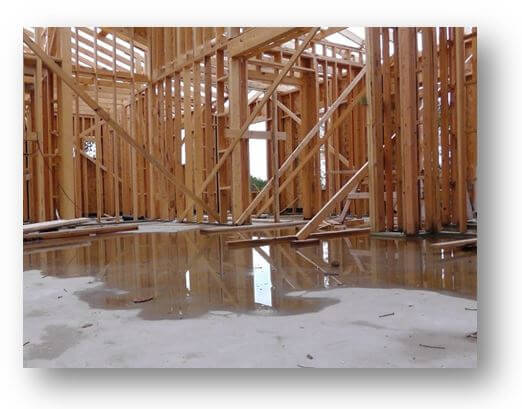As we move into the rainy season, it’s important to revisit best practices of protecting wood from the elements during construction. Previously, we used to rely on just-in-time deliveries which would limit the amount of time our framing materials were subject to the weather prior to being covered up. With today’s market environment, we find ourselves ordering materials early and storing them on site so that we can be productive as we start building and not run out of material along the way. This has led to lumber being stored for longer periods than we are used to. It’s important that this is taken into consideration as we construct our projects and that we don’t allow deterioration of our building products to occur.
First, develop a plan early to deal with these issues in order to reduce the risk of mold and product deterioration. Ensure that your storage area is well thought out, away from traffic, away from any ponds or detention areas designed to collect water, and ensure proper drainage. Additionally, make sure that suppliers protect the lumber during transportation. The lumber should be tarped or wrapped with a protective coating such as paper wrap to prevent absorbing moisture being absorbed as it is transported to site. Once the materials arrive, make sure to place them on proper dunnage. This keeps them off the ground and spaces them properly to ensure proper ventilation, so should they get wet they can dry out quickly. Ventilation is the key. Make sure that any protective materials used to protect the wood from moisture are breathable or are constructed so that air flow is not impeded. Polyethylene or similar non-porous materials act as a vapor barrier, so it is important to allow ventilation around the material to prevent condensation on the underside of the covering1.
As the building is being constructed the framing is still at risk until the roof is on and the building is dried in, so measures also need to be in place during this time. After rains, be sure to check for ponding water and clean it up quickly. Place fans where needed to promote air flow and keep the lumber dry. It may seem counterintuitive, but during this time it is important to keep the building open where it can “breath” until the weather barriers are in place.
Finally, you may want to consider hiring a remediation specialist prior to hanging drywall in case an incident arises or as a preventative measure to limit liability. These specialty contractors can apply chemicals to treat the in-place lumber materials and prevent any mold growth. These treatments can add 2 to 3 cents per square foot to the cost of the project, but offer the builder, building owner and residents peace of mind against potential mildew-related issues. In many cases, these treatments come with a certification and guarantee against mold. It is important to remember to check that any chemicals applied are compatible with any other materials in the building when it is applied, such as CVPC. It is much cheaper to address an issue early on when the structure is exposed rather than having to remove and replace finishes to treat a troublesome area.
Brian Carter
Project Manager
The Douglas Company

Read More >
